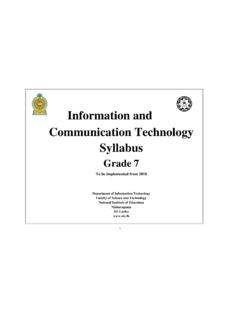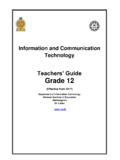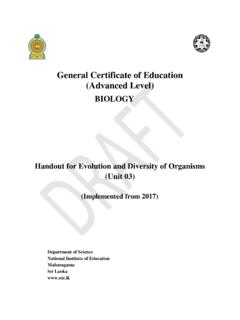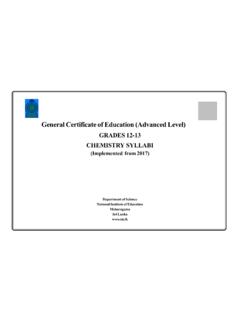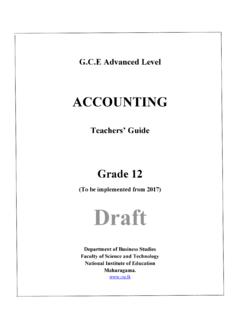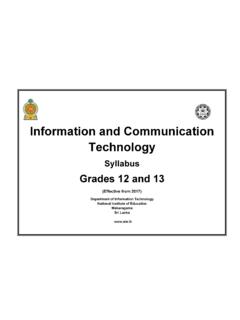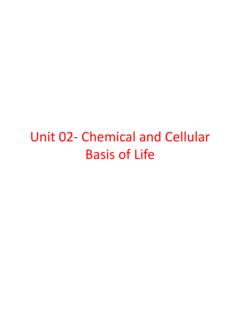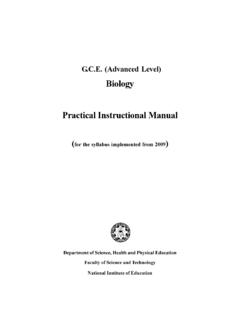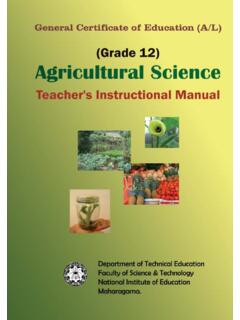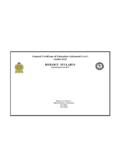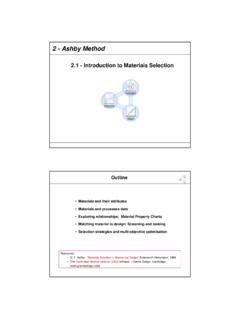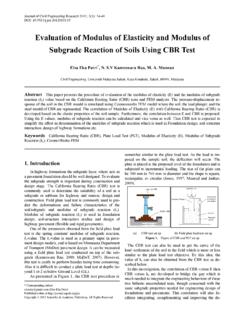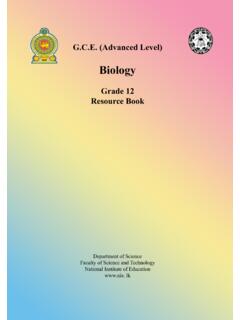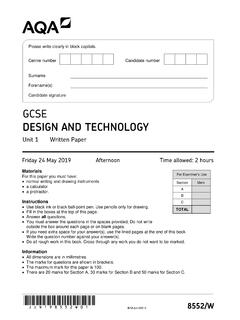Transcription of G. C. E. (Advanced Level) CHEMISTRY
1 I G. C. E. (Advanced Level) CHEMISTRY Grade 12 Resource Book Unit 4: Gaseous State of Matter Unit 5: Energetics Department of Science Faculty of Science and Technology National Institute of Education ii CHEMISTRY Resource Book Grade 12 National Institute of Education First Print 2018 Department of Science Faculty of Science and Technology National Institute of Education Sri Lanka Published by: Press National Institute of Education Maharagama Sri Lanka iii Message from the Director General The National Institute of Education takes opportune steps from time to time for the development of quality in education. Preparation of supplementary resource books for respective subjects is one such initiative. Supplementary resource books have been composed by a team of curriculum developers of the National Institute of Education, subject experts from the national universities and experienced teachers from the school system.
2 Because these resource books have been written so that they are in line with the G. C. E. (A/L) new syllabus implemented in 2017, students can broaden their understanding of the subject matter by referring these books while teachers can refer them in order to plan more effective learning teaching activities. I wish to express my sincere gratitude to the staff members of the National Institute of Education and external subject experts who made their academic contribution to make this material available to you. Dr. (Mrs.) T. A. R. J. Gunasekara Director General National Institute of Education Maharagama. iv Message from the Director Since 2017, a rationalized curriculum, which is an updated version of the previous curriculum is in effect for the (A/L) in the general education system of Sri Lanka. In this new curriculum cycle, revisions were made in the subject content, mode of delivery and curricular materials of the (A/L) Physics, CHEMISTRY and Biology.
3 Several alterations in the learning teaching sequence were also made. A new Teachers Guide was introduced in place of the previous Teacher s Instruction Manual. In concurrence to that, certain changes in the learning teaching methodology, evaluation and assessment are expected. The newly introduced Teachers Guide provides learning outcomes, a guideline for teachers to mould the learning events, assessment and evaluation. When implementing the previous curricula, the use of internationally recognized standard textbooks published in English was imperative for the Advanced Level science subjects. Due to the contradictions of facts related to the subject matter between different textbooks and inclusion of the content beyond the limits of the local curriculum, the usage of those books was not convenient for both teachers and students. This book comes to you as an attempt to overcome that issue.
4 As this book is available in Sinhala, Tamil, and English, the book offers students an opportunity to refer the relevant subject content in their mother tongue as well as in English within the limits of the local curriculum. It also provides both students and teachers a source of reliable information expected by the curriculum instead of various information gathered from the other sources. This book authored by subject experts from the universities and experienced subject teachers is presented to you followed by the approval of the Academic Affairs Board and the Council of the National Institute of Education. Thus, it can be recommended as a material of high standard. Dr. A. D. A. De Silva Director Department of Science v Guidance Dr. (Mrs.) T. A. R. J. Gunasekara Director General National Institute of Education Supervision Dr. A. D. A. De Silva Director, Department of Science National Institute of Education Mr.
5 R. S. J. P. Uduporuwa Former Director, Department of Science National Institute of Education Subject Leader Mrs. M. S. Wickramasinghe Assistant Lecturer, Department of Science National Institute of Education Internal Editorial Panel Mr. L. K. Waduge Senior Lecturer, Department of Science Mrs. G. G. P. S. Perera Assistant Lecturer, Department of Science Mr. V. Rajudevan Assistant Lecturer, Department of Science Writing Panel Dr. W. M. Bandara - Senior Lecturer, Department of CHEMISTRY , University of Peradeniya (Unit 4 and 5) Dr. Dakshika Wanniarachchi - Senior Lecturer, Instrument Center, Faculty of Applied Science, University of Sri Jayewardenepura (Unit 4) External Editorial Panel Prof. S. P. Deraniyagala - Senior Professor, Department of CHEMISTRY , University of Sri Jayewardenepura Prof. M. D. P. De Costa - Senior Professor, Department of CHEMISTRY , University of Colombo Prof.
6 H. M. D. N. Priyantha - Senior Professor, Department of CHEMISTRY , University of Peradeniya Prof. Sudantha Liyanage - Dean, Faculty of Applied Sciences, University of Sri Jayewardenepura vi Mr. K. D. Bandula Kumara - Deputy Commissioner, Education Publication Department, Ministry of Education Mrs. Muditha Athukorala - SLTS-1, Prajapathi Balika Vidyalaya, Horana Miss. C. A. N. Perera - SLTS-1, Princess of Wales , Moratuwa Mrs. V. K. W. D. Salika Madavi - SLTS-1, Muslim Ladies College, Colombo 04 Mrs. D. Manike - SLTS-1, Viharamhadevi Balika Vidyalaya, Kiribathgoda Mrs. Deepika Nethsinghe - SLTS-1 (Rtd), Ladies College, Colombo 07 Mr. S. Thillainathan - SLTS-1 (Rtd), Hindu Ladies College, Colombo 06 Miss. S. Veluppillai - SLTS-1 (Rtd), Hindu Ladies College, Colombo 06 Mrs. M. Thirunavukarasu - SLTS-1 (Rtd), Hindu Ladies College, Colombo 06 Mrs. S. Rajadurai - SLTS-1 (Rtd), St. Peters' College, Colombo 04 Language Editing Dr.
7 Chandra Amarasekara Consultant, National Institute of Education Mr. M. A. P. Munasinghe Chief Project Officer (Rtd.), National Institute of Education Cover Page Mrs. R. R. K. Pathirana Technical Assitant, National Institute of Education Supporting Staff Weerawardana Mr. Mangala Welipitiya Mr. Ranjith Dayawansa vii Content Message from the Director General .. iii Message from the Director .. iv Team of resource persons .. v Unit 4 Gaseous state of Organization of particles in three principal states and their typical Gaseous Gas laws Boyle law (pressure volume relationship) Charles law (temperature volume relationship) Avogadro law (amount volume relationship) Molar volume Combined gas law Dalton law of partial Partial pressure in terms of mole fraction Molecular kinetic theory of Assumptions of the molecular kinetic theory of an ideal gas Equation of molecular kinetic theory Root mean square speed and mean speed Maxwell - Boltzmann distribution Amendments to ideal gas equation to apply for real van der Waals equation Critical temperature and liquefaction of gases Unit 5 Basic terms in thermochemistry and System, surrounding and boundary Types of systems Properties of a system State of a system Enthalpy (H)
8 Heat Enthalpy changes and standard enthalpy changes associated with different thermochemical Exothermic and endothermic processes Thermochemical equations Enthalpy diagrams Enthalpy changes and standard enthalpy changes Indirect determination of H( ): Hess law viii Lattice enthalpy or enthalpy of formation of an ionic compound: Born-Haber Spontaneity of chemical (A/L) CHEMISTRY : UNIT 4 Gaseous state of matter 1 Content of particles in three principal states and their typical characteristics Gaseous state Gas laws Ideal gas and ideal gas equation Calculations based on ideal gas equation Boyle law (pressure volume relationship) Charles law (temperature volume relationship) Avogadro law (amount volume relationship) Molar volume (Vm)
9 Combined gas law Dalton law of partial pressure Partial pressure in terms of mole fraction kinetic theory of gases Assumptions of the molecular kinetic theory of an ideal gas Equation of molecular kinetic theory Root mean square speed and mean speed Maxwell - Boltzmann distribution Amendments to ideal gas equation to apply for real gases van der Waals equation Critical temperature and liquefaction of gases 1. Gaseous State of Matter (A/L) CHEMISTRY : UNIT 4 Gaseous state of matter 2 Introduction Everything in the universe has a chemical identity. We know that the smallest particle of matter is an atom. Study of matter and the changes that it undergoes can simply be understood as the basic definition of CHEMISTRY . Usually matter is anything that occupies space and has mass and can be seen and touched (such as soil, water) as well as things we cannot see such as air.
10 Based on the composition and properties, several categories such as substances, mixtures, elements as well as atoms and molecules can be identified. All substances, at least in principle, can exist in three states: solid, liquid and gas. In a solid, particles are held tightly and close together in an ordered structure with a definite shape having a small degree of motion. Particles in a liquid are close together but are not held so tightly in position and can move faster compared to that of solid. Gases differ largely from liquids and solids in the distances between the particles. In a gas, the particles are separated by distances, large compared with the size of the particles allowing them to behave freely. Therefore, the attractive forces between gas particles are very small or negligible and that allows us to consider gas particles individually and some hypotheses are easily predictable depending on the temperature and pressure changes.
